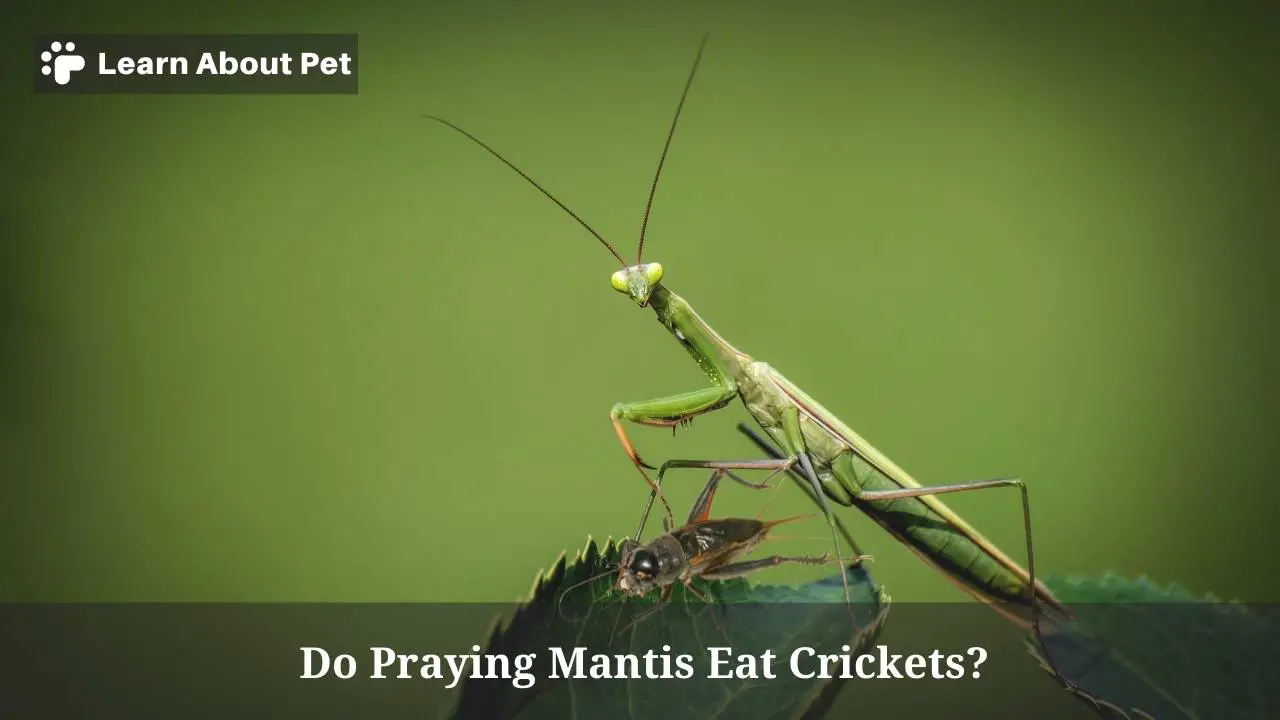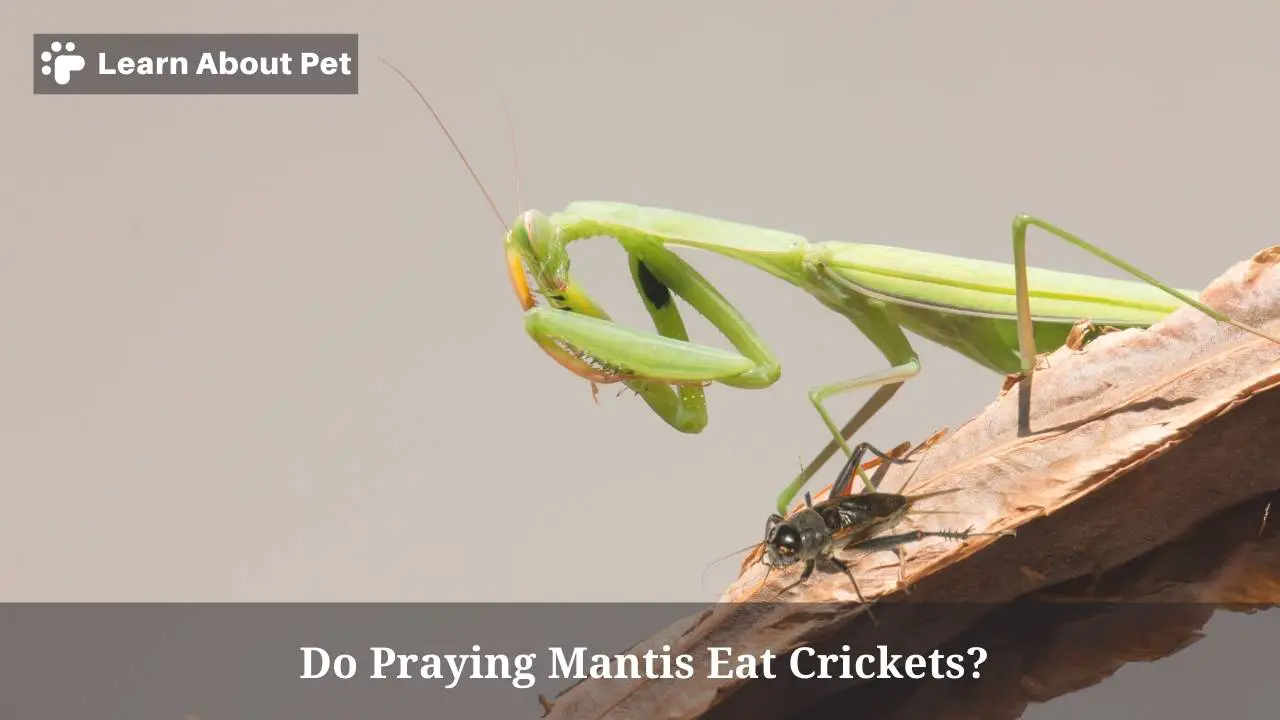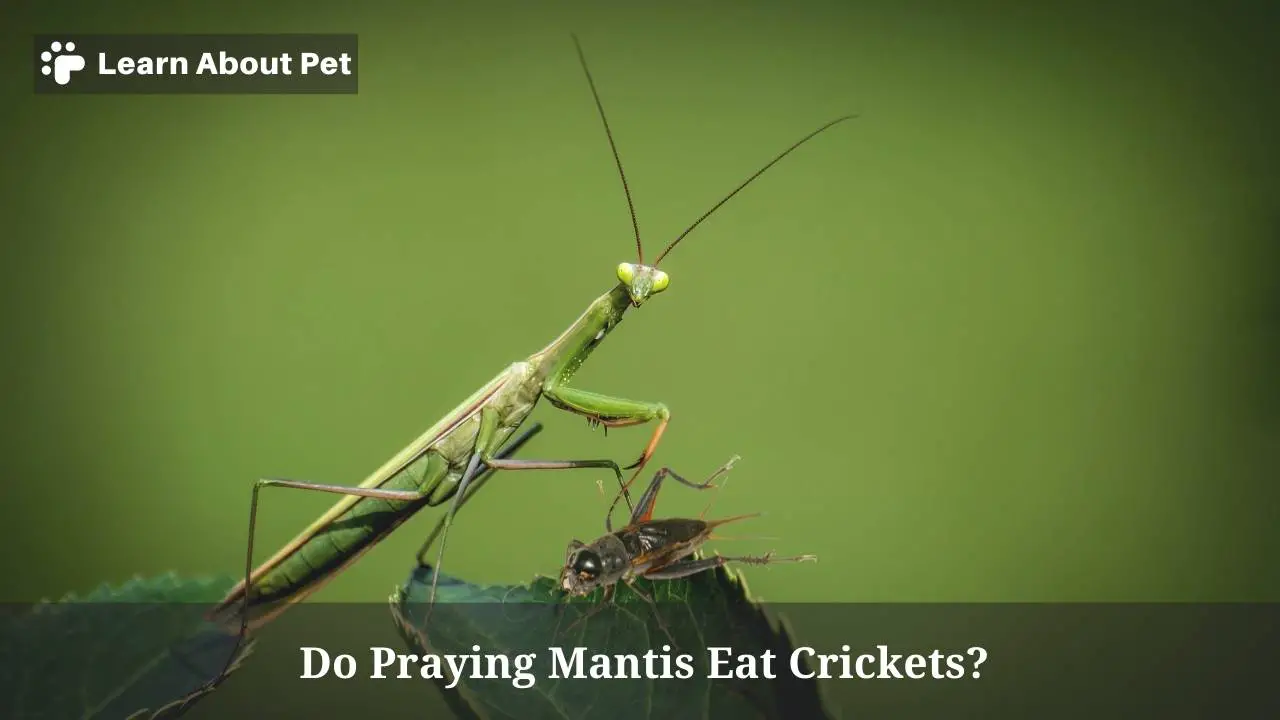The praying mantis is a grasshopper family and one of the predators or voracious carnivores. When praying mantis is hungry, they can implement strategies to keep patience and give surprise attacks to prey until they can get what they are looking for.
Praying mantis will hunt insects, lizards, frogs, spiders, or birds. Although there are food types praying mantis are looking for, are crickets safe for praying mantids?
Do praying mantis eat crickets? Yes, praying mantis can eat as many crickets as they want as long as their arms can reach the crickets around them. But be careful if you want to give the cricket portion as the mantis’ primary diet because some mantis experience unexplained symptoms, such as vomiting and fatal conditions after overeating it.

Knowing the effect of mantis when eating cricket is a piece of new information for us. Let’s find out more in this article.
Do Praying Mantis Eat Crickets?
The praying mantis is the fiercest predator among insects. They can stay in the undergrowth, leaves, or stems, and they will ambush prey with their lightning speed and agile arm. Crickets are easy targets for mantis if they are in attack range.
Crickets make a lot of noise. Mantis can take advantage of the sound of crickets by approaching him slowly without crickets noticing any problems. Crickets can hop elsewhere, but it’s no big deal for the mantis ambushing them.
Can praying mantis eat crickets? Yes, praying mantis can eat crickets once they get hold of them. Mantis will start by eating his head, then can consume all parts of the body of the crickets without residue.
Can Baby Praying Mantis Eat Crickets?
Baby mantises will eat any insects they can hunt. Some common foods for baby mantises are leafhoppers, aphids, and fruit flies. Crickets are still a little too big for baby mantis as they still can’t ambush with their sharp arms.
Once the baby mantis has grown, it can start hunting for crickets or other larger food. The baby mantis will eat once every 3-4 days.
If you want to find the right food for a pet baby mantis, look for small insects by measuring how the baby mantis can take the food.
Do Praying Mantis Eat Live Crickets?
Wild praying mantis can look for live crickets at night when the crickets make a loud sound. The praying mantis will begin to approach the crickets and ambush them without the crickets noticing the mantis’ presence.
There is no serious problem if a mantis hunts crickets in the wild, and the mantis enjoys eating them without residue.
Many problems are experienced by mantis owners when deciding to give cricket to their pets. There is a mantis who vomits or dies after eating a few crickets.
Although there are many possibilities for this, there are also mantis who do not have any problems eating live crickets.
Can mantis eat crickets? Yes, crickets are one of the favorite food lists for mantis. Mantis is used to hunting cricket in the wild because it is easy to get it at night.
Do Praying Mantis Eat Dead Crickets?
Mantis is not so interested in dead insects. They prefer to prey on live insects because mantis is voracious predators who want to ambush and eat their prey.
The more crickets move or run away from the mantis, the more the mantis will want to eat them.
Pet owners think giving dead crickets will make it easier for pet mantis to eat them. But this method will only reduce the mantis’ appetite because they do not want to hunt dead insects.
Do Praying Mantis Eat Frozen Crickets?
Praying mantis doesn’t like frozen crickets because it’s not live food. Mantis wants to hunt their prey by ambushing them. Frozen crickets have a solid texture that makes it difficult for the mantis to eat them.
Maybe there are some pet mantis who are used to eating frozen crickets because they are used to it, but the mantis still prefers live crickets.
Let mantis follow their instincts in search of live food because they are voracious carnivores. We cannot force our pets to eat dead insects because they can lose interest in eating.
Are Crickets Bad For Mantises?
Mantis are not natural predators of crickets. Snakes, birds, bats, and lizards are cricket’s natural predators, but mantis is not afraid to seek out crickets and use them as food.
Crickets can give unpleasant surprises to mantis, either harmful substances or crickets can fight when mantis attack them.
Some mantis will vomit after ingesting a cricket because there is a possibility of viruses or bacteria in the cricket. But wild mantis will not know cricket can harm their body because they only eat prey they can catch.

Can Praying Mantis Eat Black Crickets?
Some crickets, like black crickets, contain bacteria that can cause diarrhea or fatal conditions for mantis. But this does not happen to all types of the mantis because there are owners who give their pets black crickets, and there is no effect.
One or two black crickets will not have any effect on your mantis. Watch a few minutes after the mantis eats the black cricket. If there are symptoms such as vomiting or losing balance on the mantis, stop giving black cricket any longer.
Do Crickets Eat Baby Praying Mantis?
There are no references or reports of cricket eating baby praying mantis. Some sizable baby praying mantis can start hunting crickets for their food.
Baby praying mantis are about the same size as crickets, and mantises don’t have a problem if they have to eat foods that are almost the same size as their bodies.
Some possibilities of crickets are that they can give digestive problems to baby praying mantis due to a large number of bacteria or viruses in the cricket’s body.
Baby praying mantis will forage for food smaller than crickets, as long as they can ambush them with their sharp arm.
How Many Crickets Does A Praying Mantis Eat?
Don’t give mantis more than two crickets at a time, or one cricket every other day. Mantis can eat a full cricket with proportionate size without leftovers. The bigger the mantis, the more they enjoy a full cricket.
Watch the mantis after eating the cricket. If they experience problems such as vomiting, then there is a possibility that the mantis has eaten too much cricket or that cricket contains viruses or bacteria.
Wild praying mantis will only chase one prey and finish it. No mantis wants to take more than one prey at a time.
Is it Safe To Feed Crickets To Your Praying Mantis?
Although many reports say it is dangerous to give cricket to the mantis, there is no harm in trying to give one or two crickets per time the mantis eats.
See the reaction of the mantis when they eat cricket, whether they enjoy the food without any problems and can finish it without leftovers.
Do praying mantis eat crickets? Yes, pet mantis can eat one cricket every other day. Pet owners can get cricket in various ways, there are by mail, by buying at a pet store, or by catching it directly in the wild. As long as you can serve it live, then the mantis will enjoy eating a cricket.
Will Praying Mantis Eat Crickets?
Wild praying mantis will eat crickets if they can find them. Crickets are a pest that is often around the house and keeps producing sounds round the clock.
If you have a lot of praying mantis as pets, you can make the mantis a hunter and will eat crickets around the house.
Although mantis has a strategy to approach their prey and ambush as fast as possible, crickets can use the “freeze” method when they feel there is a threat around them.
Even though the crickets can jump or fly away, the crickets choose to freeze so that they trick the mantis who wants to hunt them down.
If you are looking for an alternative to cricket, the table below will help you determine which foods are suitable for mantis.
| Praying mantis food | Examples |
| Insects | Moths, crickets, grasshoppers |
| Bugs | Beetles, ladybugs, butterflies, stink bugs |
| Worms | Mealworms, silkworms |
| Birds | Hummingbirds |
| Small amphibians | Frogs |
How To Care For Praying Mantis That Ate Too Many Crickets?
Overfeeding mantis will shorten their lifespan. You have to give a distance for their next meal up to another 2 days. Let the mantis expel their food like vomiting and do not give any food to maintain the mantis’ condition.
How many crickets should I feed my mantis? One cricket is enough every time the mantis wants to eat. The size of the crickets will be adjusted to the size of the mantis. If you have big mantis, you can give up to 2 little crickets.
Do Praying Mantis Eat Crickets In The Wild?
Yes, if you have a garden with crickets as a pest, then praying mantis will be suitable as voracious eaters for these pests. Mantis can eat both flying and ground-dwelling species, such as crickets, moths, grasshoppers, caterpillars, and beetles.
Final Verdict – Do Praying Mantis Eat Crickets
Praying mantis is not one of the main predators for crickets, but mantis can enjoy eating crickets. Pet mantis or wild mantis like to hunt crickets because they have a loud sound and deserve to be prey.

Mantis will start his strategy to approach the crickets slowly until they manage to ambush him quickly.
Some mantis owners say some types of cricket can cause mantis vomit because crickets may contain viruses or bacteria. You can safely give one or two crickets per serve by adjusting the mantis’ size.
As a pet lover, make sure to learn about pet more and give your pet mantis a good and comfortable life!

Welcome to Learn About Pet. My name is Rajkumar Ravichandran and I love all pets, travel, and amazing food. I write about my passion and personal experience caring for multiple pets in this blog! ❤️
Post Disclaimer
DISCLAIMER: THIS BLOG OR WEBSITE, "Learn About Pet", DOES NOT PROVIDE YOU WITH MEDICAL ADVICE AND IS NOT A SUBSTITUTE FOR MEDICAL ADVICE. ALWAYS GET IN TOUCH WITH YOUR PERSONAL VETERINARIAN AND USE INFORMATION HERE AS GENERAL ADVICE.
The information, including but not limited to, text, graphics, images and other material contained on this website are for informational purposes only. No material on this site is intended to be a substitute for professional veterinary advice, food recommendation, diagnosis, or treatment. Always seek the advice of your veterinarian or other qualified health care provider with any questions you may have regarding a medical condition or for pet food related questions.







